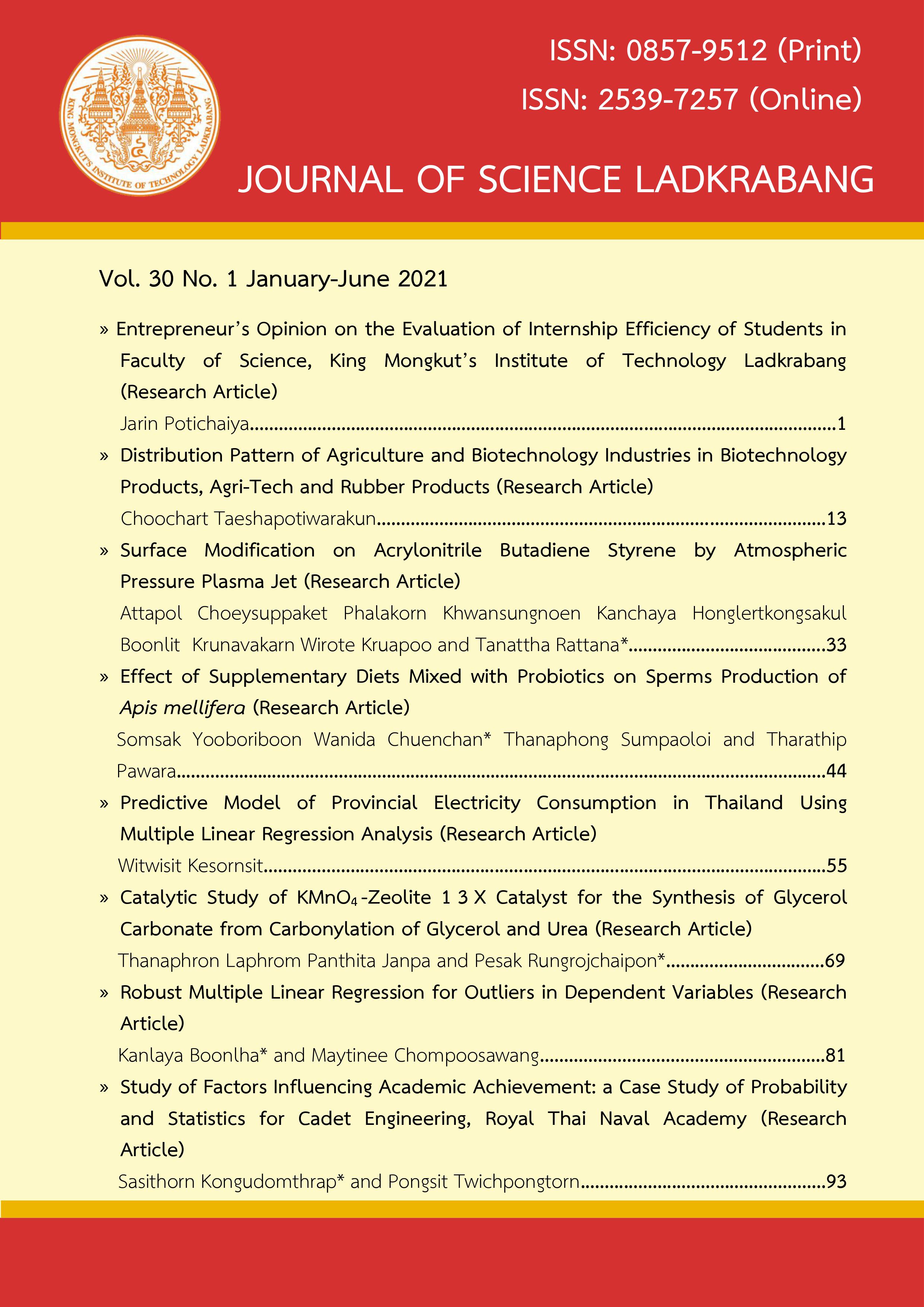Effect of Supplementary Diets Mixed with Probiotics on Sperms Production of Apis mellifera
Main Article Content
Abstract
The research aimed to study the effect of supplementary diets mixed with probiotics on sperms production of Apis mellifera. Four species of the probiotics were Lactobacillus casei TISTR 390, L. plantarum TISTR 541, L. curvatus TISTR 938 and L. acidophilus TISTR 2365. Taking a random sampling of marked drones for 7, 14, 21, 28 and 35 days (5 drones/hive) and collected semen, counting the number of sperms by haemacytometer under microscope (400X). The result showed that all test could produce the highest sperms on 14 days. In accordance with the research, it’s found that the number of sperms from drones fed with supplementary diet mixed with probiotics from the highest to the lowest is L. plantarum (2.095±0.147×106 cells/µl), L. casei (1.359±0.169×106 cells/µl), L. curvatus (1.300±0.185×106 cells/µl) and L. acidophilus (1.214±0.120×106 cells/µl) respectively. In which the drones treated with supplementary diet mixed with probiotic in all test could produce more sperms than the drones fed with natural food (8.790±0.300×105) and drones fed with supplementary diet that do not contain probiotics (8.606±0.742×105), significantly different (p≤0.05). The research indicates that all the four species of probiotics can be progressively developed to be mixture of supplementary diet for A. mellifera.
Article Details
References
บุญมี กวินเสกสรรค์. 2558. โรคและศัตรูของผึ้งและชันโรง. สำนักบริหารและพัฒนาวิชาการ (สำนักพิมพ์) มหาวิทยาลัยแม่โจ้, เชียงใหม่. [Boonmee Kavinseksan. 2015. Diseases and Pests of Honey Bees and Stingless Bees, Maejo Digatal Printing hous, MaejoPress Co.,Ltd. Maejo university, Chiangmai. (in Thai)]
ทะนุพงศ์ กุสุมา ณ อยุธยา. 2562. ผึ้งได้งาน คนเลี้ยงได้เงิน. เทคโนโลยีชาวบ้าน.แหล่งข้อมูล : เว็บไซต์https://www.technologychaoban.com/bullet-news-today/article_132602. ค้นเมื่อวันที่ 3 พฤษภาคม 2563.
ภาณุวรรณ จันทวรรณกูร และจักราวุธ ไม้ทิพย์. 2560. การพัฒนาเทคโนโลยีใหม่สำหรับการเลี้ยงผึ้งและผลิตภัณฑ์ผึ้ง : ผลงานวิจัยสู่การใช้ประโยชน์. จดหมายข่าว วช., 12(77), 5-7. [Panuwan Chantawannakul and Jakkrawut Maitip. 2017. Novel Technologies for Beekeeping and Bee Product Industries. Results into Utilization. NRCT Newsletter, 12(77), 5-7 (in Thai)]
สิริวัฒน์ วงษ์ศิริ และนิคม โคตรสุวรรณ. 2562. บทความพิเศษชุด : ความหวานและอำนาจ-หอบรังผึ้งหาแหล่งความหวาน (2), แหล่งข้อมูล : https://isaanrecord.com/ 2019/09/20/sweetness -and-power-part-12-th/. ค้นเมื่อวันที่ 30 มีนาคม 2563.
ภาณุวรรณ จันทวรรณกูร, วรรณจันทร์ แสงหิรัญ ลี, ปิยรัตน์ นิมมานพิภักดิ์ และศศิประภา ครองแดง. 2561. ผึ้ง สารฆ่าแมลง ผลกระทบต่อระบบนิเวศ และสุขภาพของมนุษย์. กลุ่มธุรกิจแม็กซ์, เชียงใหม่. [Panuwan Chantawannakul, Vannajan Sanghiran Lee, Piyarat Nimmanpipug and Sasiprapa Krongdaeng. 2018. Bee, Insect Toxins, Impact on The Ecosystem and Human Health, MaxxPRINTINGTM, Chiangmai. (in Thai)]
Fisher, A., II. and Range, J. 2018. Exposure to pesticides during development negatively affects honey bee (Apis mellifera) drone sperm viability. PLoS ONE, 13(12), e0208630. https://doi.org/ 10.1371/journal.pone.0208630.
ชัยวัฒน์ ไชยสุต. 2554. โพรไบโอติก: จุลินทรีย์เพื่อชีวิต. อินฟินิตี้ คัลเลอร์ พริ้นติ้ง, กรุงเทพฯ. [Chaiwat Chaiyasut. 2011. Probiotics: Microoranisms for life. 1st ed, Infinity color Print Co.,Ltd., Bangkok. (in Thai)]
Mountzouris, K., Tsitrsikos, P., Palamidi, I., Arvaniti, A., Mohnl, M., Schatzmayr, G. and Fegeros, K. 2010. Effects of probiotic inclusion levels in broiler nutrition on growth performance, nutrient digestibility, plasma immunoglobulins, and cecal microflora composition. Poultry Science, 89(1), 58–67.
Rousseau, A., Fournier, V. and Giovenazzo, P. 2015. Apis mellifera (Hymenoptera: Apidae) drone sperm quality in relation to age, genetic line, and time of breeding. The Canadian Entomologist, 147(6), 702-711.
Meidong, R., Khotchanalekha, K., Doolgindachbaporn, S., Nagasawa, T., Nakao, M., Sakai, K. and Tongpim, S. 2017. Evaluation of probiotic Bacillus aerius B81e isolated from healthy hybrid catfish on growth, disease resistance and innate immunity of Pla-mong Pangasius bocourti. Fish and Shellfish Immunology, 73, 1-10.
Ciereszko, A., Wilde, J., Dietrich, G.J., Siuda, M., Bak, B., Judycka, S. and Karol, H. 2017. Sperm parameters of honeybee drones exposed to imidacloprid. Apidologie, 48(2), 211–222.
Czekonska, K., Mickiewicz, B.C. and Chorbinski, P. 2013. The influence of honey bee (Apis mellifera) drone age on volume of semen and viability of spermatozoa. Journal of Apicultural Science, 57(1), 61-66.
Gontarz, A., Banaszewska, D., Gryzinska, M. and Andraszek, K. 2016. Differences in drone sperm morphometry and activity at the beginning and end of the season. Turkish Journal of Veterinary and Animal Sciences, 40, 598-602.
Rangel, J. and Fisher, A. II. 2019. Factors affecting the reproductive health of honey bee (Apis mellifera) drones-a review. Apidologie, 50, 759–778.
Ben Abderkader, F., Kairo, G., Tchamitchian, S., Bonnet, M., Cousin, M., Barbouche, N., Belzunces, L.P., and Luc Brunet, J. 2018. Effects of Clothianidin exposure on semen parameters of honey bee drones. Journal of new sciences Agriculture & Biotechnology, 59(1), 3791-3798.

